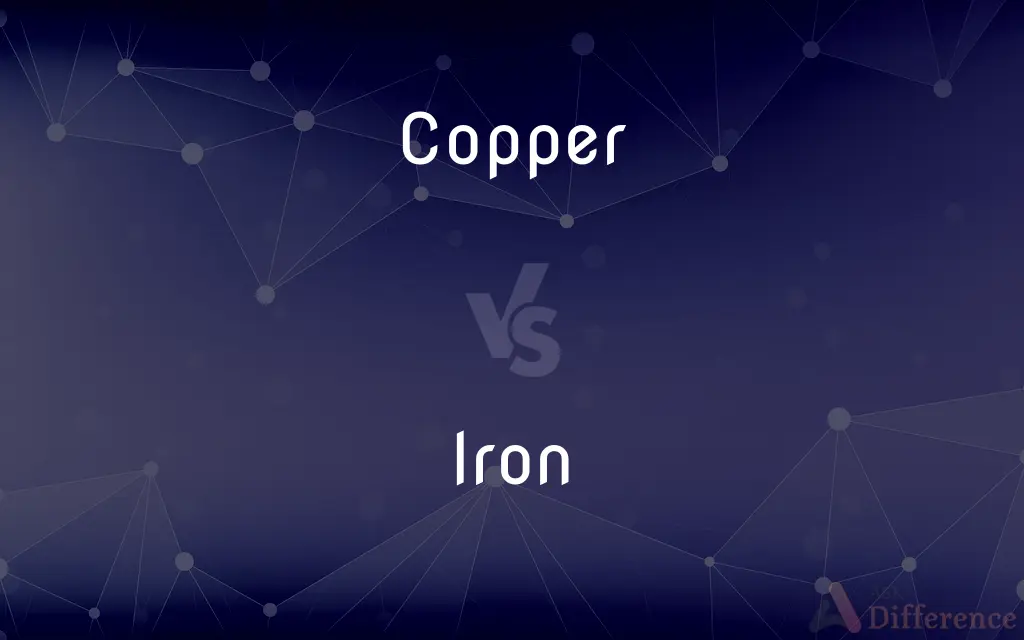Copper vs. Iron — What's the Difference?
By Tayyaba Rehman — Updated on October 9, 2023
Copper, a ductile and malleable metal, is renowned for its excellent conductivity, while Iron, a strong and magnetic metal, is notable for its fundamental role in producing steel.

Difference Between Copper and Iron
Table of Contents
ADVERTISEMENT
Key Differences
Copper is known for its distinct reddish-brown color and its excellent electrical and thermal conductivity. In contrast, Iron, exhibiting a silvery appearance, is characterized by its magnetic properties, distinguishing itself through not only its appearance but also through its utility and physical characteristics compared to Copper.
The uses of Copper and Iron differ significantly across various industries due to their distinct physical properties. Copper, being resistant to corrosion and highly conductive, is prominently utilized in electrical wiring, electronic devices, and for corrosion-resistant parts. On the other hand, Iron, due to its strength and abundance, is predominantly employed in construction and manufacturing, often being alloyed to produce steel.
Copper and Iron have distinct impacts on human health and are utilized differently in biological processes. Copper is an essential trace dietary mineral vital for survival, playing a pivotal role in maintaining healthy metabolic processes. Whereas, Iron, vital for transporting oxygen in the blood via hemoglobin, holds a foundational status in biological systems, demonstrating the disparate biological roles and nutritional significance of Copper and Iron.
In historical and cultural contexts, Copper and Iron have been emblematic in designating respective ages of human civilization, underlining their respective influences in the development of societies. The Copper Age reflects the utilization of the metal in tools and artifacts, while the Iron Age symbolizes a period where Iron became predominantly used, elucidating the historical progress from using Copper to Iron due to technological and discovery advancements.
From a financial and economic standpoint, Copper is often referred to as "Dr. Copper" due to its capacity to predict economic trends due to its wide-ranging applications. Conversely, Iron, particularly in the form of steel, is often a measure of industrial development and production levels, marking the differential economic indicators and investment profiles for Copper and Iron.
ADVERTISEMENT
Comparison Chart
Color
Reddish-brown
Silvery, often with a rusty appearance
Conductivity
Excellent electrical and thermal conductivity
Poor conductor compared to Copper
Magnetic Property
Non-magnetic
Magnetic
Biological Role
Essential in metabolic processes
Fundamental in oxygen transport via hemoglobin
Historical Significance
Defines the Copper Age
Symbolizes the Iron Age
Compare with Definitions
Copper
Copper is a reddish-brown metallic element.
The statue was made of Copper due to its resistance to corrosion.
Iron
Iron is a strong and durable metal.
Iron bars are commonly used in constructing buildings.
Copper
It's known for excellent electrical conductivity.
Copper wiring is prevalent in electrical installations.
Iron
Known for its magnetic properties.
Iron filings are often used to demonstrate magnetic fields.
Copper
Copper is malleable and ductile.
Artists use Copper for creating intricate sculptures.
Iron
Iron is essential for producing hemoglobin.
An adequate amount of Iron prevents anemia.
Copper
Copper is utilized in various alloys.
Bronze, an alloy of Copper, was used in ancient tools.
Iron
Iron () is a chemical element with symbol Fe (from Latin: ferrum) and atomic number 26. It is a metal that belongs to the first transition series and group 8 of the periodic table.
Copper
Copper is a chemical element with the symbol Cu (from Latin: cuprum) and atomic number 29. It is a soft, malleable, and ductile metal with very high thermal and electrical conductivity.
Iron
Symbol Fe A silvery-white, lustrous, malleable, ductile, magnetic or magnetizable, metallic element occurring abundantly in combined forms, notably in hematite, limonite, magnetite, and taconite, and used alloyed in a wide range of important structural materials. Atomic number 26; atomic weight 55.845; melting point 1,538°C; boiling point 2,861°C; specific gravity 7.874 (at 20°C); valence 2, 3, 4, 6. See Periodic Table.
Copper
Symbol Cu A ductile, malleable, reddish-brown metallic element that is an excellent conductor of heat and electricity and is widely used for electrical wiring, water piping, and corrosion-resistant parts, either pure or in alloys such as brass and bronze. Atomic number 29; atomic weight 63.546; melting point 1,085°C; boiling point 2,562°C; specific gravity 8.96; valence 1, 2. See Periodic Table.
Iron
An implement made of iron alloy or similar metal, especially a bar heated for use in branding, curling hair, or cauterizing.
Copper
A coin, usually of small denomination, made of copper or a copper alloy.
Iron
Great hardness or strength; firmness
A will of iron.
Copper
Chiefly British A large cooking pot made of copper or often of iron.
Iron
(Sports) Any of a series of golf clubs having a bladelike metal head and numbered from one to nine in order of increasing loft.
Copper
Any of various small butterflies of the subfamily Lycaeninae, having predominantly copper-colored wings.
Iron
A metal appliance with a handle and a weighted flat bottom, used when heated to press wrinkles from fabric.
Copper
A reddish brown.
Iron
A harpoon.
Copper
A police officer.
Iron
Irons Fetters; shackles.
Copper
To coat or finish with a layer of copper.
Iron
A tonic, pill, or other medication containing iron and taken as a dietary supplement.
Copper
(Slang) To bet against, as in faro.
Iron
Made of or containing iron
Iron bars.
An iron alloy.
Copper
(uncountable) A reddish-brown, malleable, ductile metallic element with high electrical and thermal conductivity, symbol Cu, and atomic number 29.
Iron
Strong, healthy, and capable of great endurance
An iron constitution.
Copper
The reddish-brown colour/color of copper.
Iron
Inflexible; unyielding
Iron resolve.
Copper
Any of various specialized items that are made of copper, where the use of copper is either traditional or vital to the function of the item.
Iron
Holding tightly; very firm
Has an iron grip.
Copper
(countable) A copper coin, typically of a small denomination, such as a penny.
Iron
To press and smooth with a heated iron
Iron clothes.
Copper
A large pot, often used for heating water or washing clothes over a fire. In Australasia at least, it could also be a fixed installation made of copper, with a fire underneath and its own chimney. Generally made redundant by the advent of the washing machine.
Mum would heat the water in a copper in the kitchen and transfer it to the tin bath.
I explain that socks can’t be boiled up in the copper with the sheets and towels or they shrink.
Iron
To remove (creases) by pressing.
Copper
(entomology) Any of various lycaenid butterflies with copper-coloured upperwings, especially those of the genera Lycaena and Paralucia.
Iron
To put into irons; fetter.
Copper
A police officer.
Iron
To fit or clad with iron.
Copper
Made of copper.
Iron
To iron clothes.
Copper
Having the reddish-brown colour/color of copper.
Iron
(uncountable) A common, inexpensive metal, silvery grey when untarnished, that rusts, is attracted by magnets, and is used in making steel.
Copper
To sheathe or coat with copper.
Iron
A metallic chemical element having atomic number 26 and symbol Fe.
Copper
A common metal of a reddish color, both ductile and malleable, and very tenacious. It is one of the best conductors of heat and electricity. Symbol Cu. Atomic weight 63.3. It is one of the most useful metals in itself, and also in its alloys, brass and bronze.
Iron
Any material, not a steel, predominantly made of elemental iron.
Wrought iron, ductile iron, cast iron, pig iron, gray iron
Copper
A coin made of copper; a penny, cent, or other minor coin of copper.
My friends filled my pockets with coppers.
Iron
(countable) A tool or appliance made of metal, which is heated and then used to transfer heat to something else; most often a thick piece of metal fitted with a handle and having a flat, roughly triangular bottom, which is heated and used to press wrinkles from clothing, and now usually containing an electrical heating apparatus.
Copper
A vessel, especially a large boiler, made of copper.
Iron
(usually plural, irons) shackles.
Copper
The boilers in the galley for cooking; as, a ship's coppers.
All in a hot and copper sky.
Iron
(slang) A firearm, either a long gun or a handgun.
Copper
To cover or coat with copper; to sheathe with sheets of copper; as, to copper a ship.
Iron
(uncountable) A dark shade of the color silver.
Copper
A ductile malleable reddish-brown corrosion-resistant diamagnetic metallic element; occurs in various minerals but is the only metal that occurs abundantly in large masses; used as an electrical and thermal conductor
Iron
A male homosexual.
Copper
A copper penny
Iron
(golf) A golf club used for middle-distance shots.
Copper
Uncomplimentary terms for a policeman
Iron
Used as a symbol of great strength or toughness, or to signify a very strong or tough material.
A will of iron
He appeared easygoing, but inside he was pure iron.
Copper
A reddish brown the color of polished copper
Iron
(weightlifting) Weight used as resistance for the purpose of strength training.
He lifts iron on the weekends.
Copper
Any of various small butterflies of the family Lycaenidae having copper colored wings
Iron
A meteorite consisting primarily of metallic iron (mixed with a small amount of nickel), as opposed to one composed mainly of stony material.
Irons and stony irons can be much larger than stony meteorites and are much more visually striking, but make up only a few percent of all meteorites.
Copper
Coat with a layer of copper
Iron
A safety curtain in a theatre.
Copper
An essential trace dietary mineral for humans.
Copper deficiency can adversely affect human health.
Iron
Dumb bombs, those without guidance systems.
Iron
(not comparable) Made of the metal iron.
Iron
(figuratively) Strong as of will, inflexible.
She had an iron will.
He held on with an iron grip.
An iron constitution
Iron men
Iron
(transitive) To pass an iron over (clothing or some other item made of cloth) in order to remove creases.
Iron
To shackle with irons; to fetter or handcuff.
Iron
(transitive) To furnish or arm with iron.
To iron a wagon
Iron
The most common and most useful metallic element, being of almost universal occurrence, usually in the form of an oxide (as hematite, magnetite, etc.), or a hydrous oxide (as limonite, turgite, etc.). It is reduced on an enormous scale in three principal forms; viz., cast iron, steel, and wrought iron. Iron usually appears dark brown, from oxidation or impurity, but when pure, or on a fresh surface, is a gray or white metal. It is easily oxidized (rusted) by moisture, and is attacked by many corrosive agents. Symbol Fe (Latin Ferrum). Atomic number 26, atomic weight 55.847. Specific gravity, pure iron, 7.86; cast iron, 7.1. In magnetic properties, it is superior to all other substances.
Iron
An instrument or utensil made of iron; - chiefly in composition; as, a flatiron, a smoothing iron, etc.
My young soldier, put up your iron.
Iron
Fetters; chains; handcuffs; manacles.
Four of the sufferers were left to rot in irons.
Iron
Strength; power; firmness; inflexibility; as, to rule with a rod of iron.
Iron
An iron-headed club with a deep face, chiefly used in making approaches, lifting a ball over hazards, etc.
Iron
Of, or made of iron; consisting of iron; as, an iron bar, dust.
Iron
Resembling iron in color; as, iron blackness.
Iron
Like iron in hardness, strength, impenetrability, power of endurance, insensibility, etc.;
Iron
Rude; hard; harsh; severe.
Iron years of wars and dangers.
Jove crushed the nations with an iron rod.
Iron
Firm; robust; enduring; as, an iron constitution.
Iron
Inflexible; unrelenting; as, an iron will.
Iron
Not to be broken; holding or binding fast; tenacious.
Iron
To smooth with an instrument of iron; especially, to smooth, as cloth, with a heated flatiron; - sometimes used with out.
Iron
To shackle with irons; to fetter or handcuff.
Iron
To furnish or arm with iron; as, to iron a wagon.
Iron
A heavy ductile magnetic metallic element; is silver-white in pure form but readily rusts; used in construction and tools and armament; plays a role in the transport of oxygen by the blood
Iron
A golf club that has a relatively narrow metal head
Iron
Metal shackles; for hands or legs
Iron
Implement used to brand live stock
Iron
Home appliance consisting of a flat metal base that is heated and used to smooth cloth
Iron
Press and smooth with a heated iron;
Press your shirts
Iron
Extremely robust;
An iron constitution
Iron
Often alloyed to produce steel.
The strength of steel springs from its Iron component.
Iron
Iron has a silvery appearance, prone to rust.
The Iron gate deteriorated due to rust over time.
Common Curiosities
What is Iron’s role in biology?
Iron is crucial for oxygen transport in blood.
In which industry is Copper predominantly used?
Predominantly in electrical and electronics industries.
Why is Copper used in wiring?
Due to its excellent electrical conductivity.
What color is Copper?
Copper is reddish-brown.
Is Iron involved in producing steel?
Yes, Iron is a primary component in steel production.
Does Copper have a historical age named after it?
Yes, the Copper Age reflects its historical utilization.
Is Iron magnetic?
Yes, Iron is magnetic.
Can Copper be alloyed?
Yes, Copper is alloyed to form metals like Bronze.
What economic indicator is Copper often linked to?
Copper prices often correlate with economic health.
What is the Iron Age?
A historical period marked by predominant use of Iron.
What is the significance of Copper in electronics?
Copper’s conductive properties make it crucial in electronic components.
Can Iron rust?
Yes, Iron can oxidize and rust.
Is Copper essential for human health?
Yes, Copper is a vital dietary trace mineral.
Why is Iron used in construction?
Its strength and durability make it suitable for construction.
Can Iron be found in the human body?
Yes, Iron is found in hemoglobin in red blood cells.
Share Your Discovery

Previous Comparison
Riverbed vs. Riverbank
Next Comparison
Unexplainably vs. InexplicablyAuthor Spotlight
Written by
Tayyaba RehmanTayyaba Rehman is a distinguished writer, currently serving as a primary contributor to askdifference.com. As a researcher in semantics and etymology, Tayyaba's passion for the complexity of languages and their distinctions has found a perfect home on the platform. Tayyaba delves into the intricacies of language, distinguishing between commonly confused words and phrases, thereby providing clarity for readers worldwide.
















































